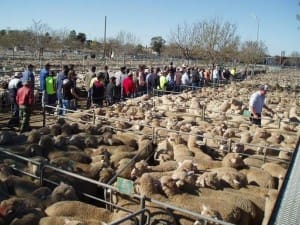
Lambs being sold at Ouyen, Victoria
OUYEN’S saleyard in Victoria’s Mallee next month plans to be the state’s first selling centre to scan and upload data from electronically-tagged lambs.
Ouyen Livestock Exchange chairman Gerald Leach and Australian Livestock Saleyards Association executive officer Mark McDonald confirmed the saleyard operators are keen to go “live” with EID scanning of the area’s first 2017-drop prime lambs at its July 13 sale.
“If they can get the software for their July sale, they want to be collecting the data and sending it up to the National Livestock Identification System (database) and being the first saleyard to go live, because they will have some tagged sheep there in July,” Mr McDonald said.
“That’s the plan at this stage, but it will depend on the software being available.”
Click here to get the latest Sheep Central story links sent to your email inbox.
Mr Leach said the OLE is the fifth biggest sheep and lamb saleyard in Victoria, with an annual average throughput of more than 300,000 sheep and lambs. He said the hardware and software for the EID scanning of sheep and data upload needed to be put in place. Scanclear’s Brendan Carey has been contracted to do the scanning and will be meeting with stakeholders next week.
Under Agriculture Victoria’s timeline for the mandatory electronic identification of sheep and goats, scanning of electronically tagged sheep and goats in saleyards, abattoirs and knackeries, with information uploaded to the NLIS database, will start on July 1. By March 31, 2018, all electronically tagged sheep and goats must be scanned in saleyards — initially at an action level above 80 percent — with this information uploaded to the NLIS database.
Horsham saleyard autodrafter trial

The Gallagher autodrafter in the Horsham saleyards.
ALSA has just finalised a series of scanner trials through its Victorian member saleyards, funded by the Victorian Government to assess scanner flows and locations. Other scanner trials have been held at Wycheproof, Bairnsdale and Geelong.
The saleyards association this week ran electronically tagged Merino lambs through a Gallagher autodrafter at Horsham in one of the trials. The exercise has indicated a potential role for autodrafters in the sale of electronically-tagged sheep and lambs. The trial involved running the lambs through the autodrafter for just scanning, scanning with weighing, and scanning with weighing and drafting.
Mr McDonald said sheep were able to be scanned at a rate of more than 2000 sheep an hour through the Gallagher sheep autodrafter. The autodrafter achieved a read rate of 100 percent.
“Even on scan, draft and weigh it was running at 700-750 an hour.
“The other thing that is good with them, is that they can be set up to draft out non-readers,” Mr McDonald said.
“You could make a case for some of the larger saleyards to have an autodrafter in a pen and if they have a problem with a sale lots with non-readers they could just run them through that and it drafts off the non-readers and you put in a post-breeder tag,” he said.
“Also if you deliver the wrong lot into a delivery pen, if you know the RFID number you can run them through the autodrafter and ‘unpack’ them, whereas now they’ve got to go through manually with bits of paper and read the ear tags to ‘unpack’ them.”
Mr McDonald said a drafting rate of 700-750 sheep an hour might be workable in some circumstances in saleyards.
“The other issue is the cost of an autodrafter comparatively speaking is similar some of the scanners and the argument could be why just have a scanner when you could have something else that could do something else for you as well.”
Horsham saleyard manager Paul Christopher said after the first lambs were pushed through the autodrafter the sheep flowed well, while it was just scanning.
“This will be a solution once we’ve got to start ear-tagging everything that doesn’t have one (an EID tag).”
Mr McDonald said with the scanner trials completed, the industry was now waiting for software to be available to do full EID tag scanning and data upload to the NLIS database.

HAVE YOUR SAY